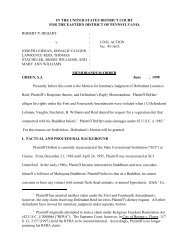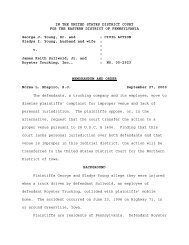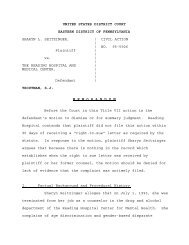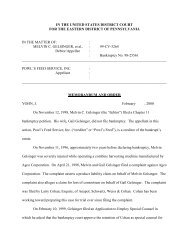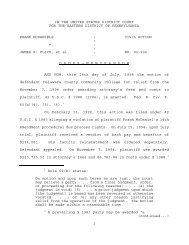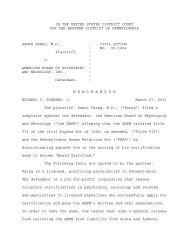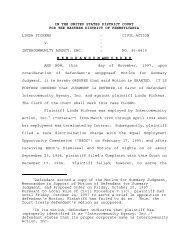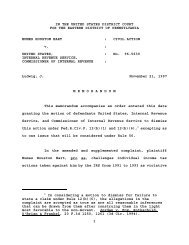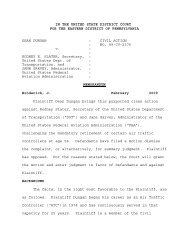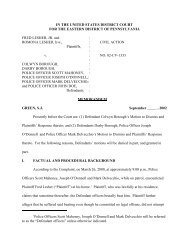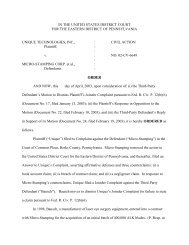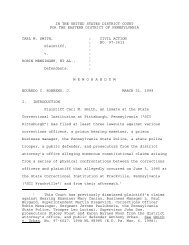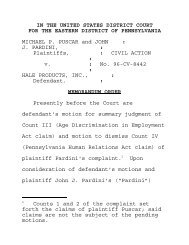1Defendant US Steel Group is alleged to be a - Eastern District of ...
1Defendant US Steel Group is alleged to be a - Eastern District of ...
1Defendant US Steel Group is alleged to be a - Eastern District of ...
Create successful ePaper yourself
Turn your PDF publications into a flip-book with our unique Google optimized e-Paper software.
IN THE UNITED STATES DISTRICT COURT<br />
FOR THE EASTERN DISTRICT OF PENNSYLVANIA<br />
BRIAN S. KOONTZ and :<br />
STANLEY ZUCZEK, :<br />
Plaintiffs, : CIVIL ACTION<br />
:<br />
v. : No. 99-3191<br />
:<br />
<strong>US</strong>X CORPORATION and :<br />
U.S. STEEL GROUP, :<br />
Defendants. :<br />
MEMORANDUM<br />
GREEN, S.J. July 2, 2001<br />
Presently <strong>be</strong>fore the court <strong>is</strong> Defendants’ Motion for Summary Judgment and the<br />
responses there<strong>to</strong>. For the reasons set forth <strong>be</strong>low, Defendants’ Motion for Summary Judgment<br />
will <strong>be</strong> granted in part and denied in part.<br />
I. FACTUAL AND PROCEDURAL BACKGROUND<br />
Plaintiffs Brian Koontz (“Plaintiff Koontz”) and Stanley Zuczek (“Plaintiff<br />
Zuczek”) (collectively “Plaintiffs”) filed a complaint against Defendants <strong>US</strong>X Corporation<br />
(“Defendant <strong>US</strong>X”) and U.S. <strong>Steel</strong> <strong>Group</strong> (“Defendant U.S. <strong>Steel</strong>”) (collectively “Defendants”) 1<br />
for <strong>alleged</strong>ly “subjecting them <strong>to</strong> d<strong>is</strong>crimination and retaliation on the bas<strong>is</strong> <strong>of</strong> their opposition <strong>to</strong><br />
d<strong>is</strong>crimination and the ass<strong>is</strong>tance they provided <strong>to</strong> female employees <strong>of</strong> Defendants who were the<br />
subject <strong>of</strong> sexual harassment by Defendants and their agents.” (Compl. 1.)<br />
Defendant <strong>US</strong>X hired Plaintiff Koontz on February 5, 1968 and Plaintiff Zuczek<br />
on April 23, 1968. (See Compl. 14.) Plaintiffs worked in the Accounting Department. During<br />
their tenure, Plaintiffs <strong>be</strong>came involved with the grievance committee for Local 5092 <strong>of</strong> the<br />
1 Defendant U.S. <strong>Steel</strong> <strong>Group</strong> <strong>is</strong> <strong>alleged</strong> <strong>to</strong> <strong>be</strong> a “wholly owned subsidiary <strong>of</strong><br />
Defendant <strong>US</strong>X Corporation.” (Compl. 9.)
United <strong>Steel</strong>workers <strong>of</strong> America, AFL-CIO (“the Union”) and bore the responsibility for<br />
processing employee grievances. (See Koontz’ Aff. at 2; Zuczek’s Aff. at 1-2.) In the Spring <strong>of</strong><br />
1996, Judy Petro-Ro<strong>be</strong>rts (“Petro-Ro<strong>be</strong>rts”) and Carol Williams (“Williams”), female employees<br />
in Defendant <strong>US</strong>X’s accounting department, complained <strong>to</strong> Plaintiff Koontz <strong>of</strong> sexual harassment<br />
by Anthony Schmidt (“Schmidt”), a male manager. (See Petro-Ro<strong>be</strong>rts’ Dep. at 31-32; Koontz’<br />
Aff. at 2.) Specifically, Schmidt served as Department Manager for General Accounting.<br />
Plaintiffs reported the complaints <strong>of</strong> sexual harassment <strong>to</strong> Ro<strong>be</strong>rt Kennedy<br />
(“Kennedy”), Defendant <strong>US</strong>X’s Employee Relations Manager, and demanded that the harassment<br />
s<strong>to</strong>p. (See Koontz’ Aff. at 2; Zuczek’s Aff. at 2.) Kennedy <strong>alleged</strong>ly assured Plaintiffs that a<br />
record <strong>of</strong> the complaints would <strong>be</strong> placed in Schmidt’s file, and Schmidt would <strong>be</strong> transferred <strong>to</strong><br />
another <strong>of</strong>fice. (See Koontz’ Aff. at 2-3; Zuczek’s Aff. at 2-3.) In or about June <strong>of</strong> 1996, Schmidt<br />
<strong>alleged</strong>ly <strong>to</strong>ld Plaintiff Zuczek that he would “fire” both Plaintiffs “for what [they had] done <strong>to</strong><br />
him.” (See Zuczek’s Dep. at 334-335; Zuczek’s Aff. at 3.) Soon thereafter, Schmidt <strong>alleged</strong>ly<br />
<strong>be</strong>gan entering h<strong>is</strong> former <strong>of</strong>fice and contacting Petro-Ro<strong>be</strong>rts and Williams by telephone and in<br />
person. (See Petro-Ro<strong>be</strong>rts’ Dep. at 33-35; Koontz’ Aff. at 3.) Along with Plaintiff Koontz,<br />
Petro-Ro<strong>be</strong>rts complained <strong>to</strong> her direct superv<strong>is</strong>or Cyril William Winslade (“Winslade”) <strong>to</strong> s<strong>to</strong>p<br />
Schmidt’s conduct. (See Petro-Ro<strong>be</strong>rts’ Dep. at 33-34; Koontz’ Aff. at 4.) Winslade <strong>alleged</strong>ly<br />
stated that he was powerless <strong>to</strong> s<strong>to</strong>p Schmidt’s conduct. (See Petro-Ro<strong>be</strong>rts’ Dep. at 33-34;<br />
Koontz’ Aff. at 4.)<br />
Also in August <strong>of</strong> 1996, Richard Walck (“Walck”), Schmidt’s replacement as<br />
Department Manager for General Accounting, <strong>is</strong>sued Plaintiff Zuczek a set <strong>of</strong> “work instructions”<br />
on how <strong>to</strong> perform h<strong>is</strong> job. (See Zuczek’s Aff. at 3; Walck’s Dep. at 21.) Plaintiff Koontz filed a<br />
2
grievance relating <strong>to</strong> the “work instructions” as a “violation <strong>of</strong> the job description section <strong>of</strong><br />
[Plaintiff Zuczek’s] contract.” (See Koontz’ Aff. at 3.) On Oc<strong>to</strong><strong>be</strong>r 25, 1996, Walck <strong>alleged</strong>ly<br />
informed Plaintiff Zuczek, in the presence <strong>of</strong> Plaintiff Koontz, that he was not performing h<strong>is</strong> job<br />
in accordance with the “work instructions.” (See Zuczek’s Aff. at 4, Koontz’ Aff. at 4.) Plaintiff<br />
Koontz claims that Walck failed <strong>to</strong> produce any reasons or documentation <strong>to</strong> support h<strong>is</strong> position.<br />
(See Koontz’ Aff. at 5.) Plaintiff Zuczek was reassigned from an accounts payable control clerk<br />
<strong>to</strong> “a temporary job in the blue print room” on Novem<strong>be</strong>r 1, 1996. (See Zuczek’s Aff. at 4.)<br />
Plaintiff Zuczek filed a grievance with the Union and a complaint with the Equal Employment<br />
Opportunity Comm<strong>is</strong>sion (EEOC) against Defendants regarding h<strong>is</strong> removal from the accounting<br />
<strong>of</strong>fice. (See Zuczek’s Aff. at 5.)<br />
In or around Novem<strong>be</strong>r or Decem<strong>be</strong>r <strong>of</strong> 1996, Schmidt <strong>alleged</strong>ly <strong>be</strong>gan entering<br />
h<strong>is</strong> former <strong>of</strong>fice with more frequency. (See Koontz’ Aff. at 7.) At the request <strong>of</strong> Petro-Ro<strong>be</strong>rts<br />
and Williams, Plaintiff Koontz filed several grievances <strong>to</strong> complain about Schmidt’s conduct.<br />
(See Def.s’ Ex.s 7, 8; Koontz’ Aff. at 7.) On January 3, 1997, a meeting was held with Plaintiff<br />
Koontz, Petro-Ro<strong>be</strong>rts, and two <strong>of</strong> Defendant <strong>US</strong>X’s managers. (See Koontz’ Aff. at 7.) During<br />
the meeting, Petro-Ro<strong>be</strong>rts explained how Schmidt sexually harassed her. (See Petro-Ro<strong>be</strong>rts<br />
Dep. at 59.) On January 14, 1997, another meeting was held with Defendants’ managers. (See<br />
Koontz’ Aff. at 8.) At said meeting, William McBunch (“McBunch”), Defendant <strong>US</strong>X’s Labor<br />
Relations Manager, <strong>alleged</strong>ly stated that Defendant <strong>US</strong>X never agreed <strong>to</strong> prevent Schmidt from<br />
entering h<strong>is</strong> former <strong>of</strong>fice, and the Union could not restrict Schmidt’s whereabouts. (See Koontz’<br />
Aff. at 8.) The following day, Kennedy met with Plaintiffs and <strong>alleged</strong>ly stated that there was a<br />
perception that Plaintiff Koontz was inciting Petro-Ro<strong>be</strong>rts and Williams <strong>to</strong> initiate sexual<br />
3
harassment claims <strong>to</strong> sat<strong>is</strong>fy Plaintiff Koontz’ personal vendetta against Schmidt. (See Koontz’<br />
Aff. at 9.) Plaintiff Koontz filed a grievance regarding Kennedy’s <strong>alleged</strong> statement. (See Def.s’<br />
Ex. 12.)<br />
On January 16, 1997, Plaintiff Koontz informed Winslade that Plaintiff Zuczek,<br />
Petro-Ro<strong>be</strong>rts, Williams, and himself “would <strong>be</strong> <strong>of</strong>f <strong>of</strong> work on union business on January 17,<br />
1997.” (See Koontz’ Aff. at 9.) Kennedy <strong>alleged</strong>ly requested a meeting with Plaintiffs. (See<br />
Koontz’ Aff. at 9.) At said meeting, Plaintiffs <strong>alleged</strong>ly informed Kennedy that they intended <strong>to</strong><br />
file charges with the EEOC against Defendants concerning Schmidt’s conduct. (See Koontz’ Aff.<br />
9, 10.) Kennedy <strong>alleged</strong>ly proposed a joint investigation with the Union regarding the sexual<br />
harassment allegations against Schmidt. (See Koontz’ Aff. at 10.) Between January 20 and<br />
January 24, 1997, Defendant <strong>US</strong>X conducted an investigation <strong>of</strong> Schmidt’s <strong>alleged</strong> conduct and<br />
concluded that no sexual harassment involving Schmidt had occurred. (See Lauritzen Dep. at 44.)<br />
In or around February <strong>of</strong> 1997, Williams was removed from the accounting <strong>of</strong>fice. (See Koontz’<br />
Aff. at 12.) Approximately three months later, on April 7, 1997, Plaintiff Zuczek, in an oral<br />
agreement with Kennedy, consented <strong>to</strong> withdraw h<strong>is</strong> grievances and EEOC charge against<br />
Defendant <strong>US</strong>X protesting h<strong>is</strong> removal from the accounting <strong>of</strong>fice provided that Defendant <strong>US</strong>X<br />
returned Williams <strong>to</strong> the accounting <strong>of</strong>fice. (See Zuczek’s Aff. at 8.)<br />
On May 30, 1997, in preparation for Defendant <strong>US</strong>X’s annual inven<strong>to</strong>ry, Plaintiffs<br />
met with Winslade and Walck <strong>to</strong> d<strong>is</strong>cuss the allocation <strong>of</strong> inven<strong>to</strong>ry work. (See Zuczek’s Aff. at<br />
8.) Plaintiffs <strong>alleged</strong>ly questioned Winslade about the scheduling <strong>of</strong> non-union employees <strong>to</strong><br />
conduct a portion <strong>of</strong> the inven<strong>to</strong>ry. (See Zuczek’s Aff. at 8.) Later that day, Plaintiffs met with<br />
John Pentin (“Pentin”), the newly assigned Department Manager for General Accounting, <strong>to</strong><br />
4
d<strong>is</strong>cuss the matter. (See Zuczek’s Aff. at 9.) During the meeting, Pentin <strong>alleged</strong>ly threatened<br />
Plaintiff Zuczek and physically assaulted Plaintiff Koontz. 2<br />
(See Koontz’ Aff. at 15-16; Zuczek’s<br />
Aff. at 9.) The following day, May 31, 1997, Plaintiff Zuczek alleges that Pentin <strong>to</strong>ld him that he<br />
would“fire” Plaintiffs if they “put any black mark on [Pentin’s] record.” (See Zuczek’s Aff. at<br />
10.)<br />
On Oc<strong>to</strong><strong>be</strong>r 4, 1997, Pentin announced that a manda<strong>to</strong>ry Safety and<br />
Communications meeting would <strong>be</strong> held on Oc<strong>to</strong><strong>be</strong>r 16, 1997 for employees in the accounting<br />
<strong>of</strong>fice. (See Def.s’ Ex. 19.) On Oc<strong>to</strong><strong>be</strong>r 15, 1997, Plaintiffs informed Walck, via voice mail<br />
messages, that they would <strong>be</strong> absent from the meeting due <strong>to</strong> <strong>of</strong>ficial union business. (See<br />
Koontz’ Aff. at 17; Zuczek’s Aff. at 10-11.) On Oc<strong>to</strong><strong>be</strong>r 20, 1997, Defendant <strong>US</strong>X suspended<br />
Plaintiffs for five (5) days for <strong>be</strong>ing “absent from work without perm<strong>is</strong>sion.” (See Def.s’ Ex. 21.)<br />
Plaintiffs filed grievances regarding their suspensions. (See Def.s’ Ex. 22.) On Oc<strong>to</strong><strong>be</strong>r 31, 1997,<br />
Plaintiffs’ attended a “due process” hearing <strong>be</strong>fore Walck and Pentin regarding Plaintiffs’<br />
suspensions. (See Zuczek’s Aff. at 12; Koontz’ Aff. at 18.) During the hearing, Plaintiff Zuczek<br />
used “pr<strong>of</strong>ane and abusive language” <strong>to</strong>ward Pentin for which he received another five (5) day<br />
suspension on Novem<strong>be</strong>r 11, 1997. (See Def.s’ Ex. 27.) On July 7, 1998, the Arbitration Board<br />
reviewed Plaintiffs’ Oc<strong>to</strong><strong>be</strong>r 20, 1997 suspensions and sustained the grievance on the ground that<br />
the five (5) day suspensions were <strong>to</strong>o severe. (See Def.s’ Ex. 23.) The Arbitration Board did not<br />
review Plaintiff Zuczek’s Novem<strong>be</strong>r 11, 1997 suspension.<br />
2 Plaintiff Koontz filed a criminal complaint relating <strong>to</strong> Pentin’s <strong>alleged</strong> physical<br />
and verbal assault against Plaintiff Koontz on May 30, 1997. (See Pl.s’ Ex. E.)<br />
5
On Novem<strong>be</strong>r 12, 1997, Plaintiffs left voice mail messages for Walck stating that<br />
they were “call[ing] in sick” so that they could attend an appointment with a psychiatr<strong>is</strong>t for a<br />
mental health evaluation. (See Koontz’ Aff. at 19; Zuczek’s Aff. at 13.) Plaintiffs submitted<br />
notes from Dr. Vic<strong>to</strong>r Nemer<strong>of</strong> (“Dr. Nemer<strong>of</strong>”) stating that neither Plaintiff should return <strong>to</strong><br />
work until further notice. (See Def.s’ Ex. 31.) On Novem<strong>be</strong>r 25, 1997, McBunch, Defendant<br />
<strong>US</strong>X’s Labor Relations Manager, wrote <strong>to</strong> Plaintiffs requesting detailed medical information<br />
regarding their diagnos<strong>is</strong>, prognos<strong>is</strong> and treatment plans. (See Def.s’ Ex. 32.) Plaintiffs<br />
submitted letters from Dr. Ro<strong>be</strong>rt H. Brick (“Dr. Brick”), dated Decem<strong>be</strong>r 2 and Decem<strong>be</strong>r 6,<br />
1997, describing Plaintiffs’ diagnoses, prognoses and treatment plans. (See Def.s’ Ex. 33.) The<br />
letters also state that Plaintiffs were not presently prepared <strong>to</strong> return <strong>to</strong> work. (See Def.s’ Ex. 33.)<br />
Defendant <strong>US</strong>X’s Medical Direc<strong>to</strong>r, Dr. Cornell Pearcy (“Dr. Pearcy”), contacted<br />
Dr. Brick <strong>to</strong> d<strong>is</strong>cuss Plaintiffs conditions, but Dr. Brick stated that, at the direction <strong>of</strong> Plaintiffs, he<br />
was not at li<strong>be</strong>rty <strong>to</strong> d<strong>is</strong>cuss those matters. (See Brick’s Dep. at 72-73.) On Decem<strong>be</strong>r 10, 1997,<br />
Defendant <strong>US</strong>X <strong>alleged</strong>ly ceased paying Plaintiff Zuczek’s salary and d<strong>is</strong>continued h<strong>is</strong> <strong>be</strong>nefits.<br />
(See Zuczek’s Aff. at 13.) On Decem<strong>be</strong>r 18, 1997, Pentin, Defendant <strong>US</strong>X’s Accounting<br />
Manager, wrote <strong>to</strong> Plaintiffs ordering Plaintiffs <strong>to</strong> report <strong>to</strong> work by Decem<strong>be</strong>r 22, 1997. (See<br />
Def.s’ Ex. 35.) On Decem<strong>be</strong>r 22, 1997, Plaintiffs were suspended for “[r]efusal <strong>to</strong> report <strong>to</strong> work<br />
as directed.” (See Def.s’ Ex. 36.) On January 5, 1998, Defendant <strong>US</strong>X terminated Plaintiffs’<br />
employment for failure <strong>to</strong> return <strong>to</strong> work on Decem<strong>be</strong>r 22, 1997.<br />
6
On May 5, 1998, an arbitration hearing was held regarding Plaintiffs’ Oc<strong>to</strong><strong>be</strong>r 20,<br />
1997 suspensions for “<strong>be</strong>ing absent from work without perm<strong>is</strong>sion.” 3 (See Def.s’ Ex. 23.) The<br />
arbitration panel ruled that Plaintiffs’ Oc<strong>to</strong><strong>be</strong>r 20, 1997 suspensions for “<strong>be</strong>ing absent without<br />
perm<strong>is</strong>sion lacked proper cause.” (See Def.s’ Ex. 23.) On or about June 17, 1998, an arbitration<br />
hearing was held regarding Plaintiffs’ January 5, 1998 d<strong>is</strong>charges for failure <strong>to</strong> return <strong>to</strong> work.<br />
(See Pl.s’ Ex. 8.) The arbitration panel ruled that Defendant <strong>US</strong>X lacked proper cause <strong>to</strong><br />
d<strong>is</strong>charge Plaintiffs, and Plaintiffs were <strong>to</strong> <strong>be</strong> reinstated and granted full pay and <strong>be</strong>nefits. (See<br />
Pl.s’ Ex. 8.) Defendant <strong>US</strong>X rescinded Plaintiff Koontz’ suspension and d<strong>is</strong>charge on or about<br />
Oc<strong>to</strong><strong>be</strong>r 27, 1998. However, Plaintiff Koontz was suspended on Oc<strong>to</strong><strong>be</strong>r 31, 1998 and then<br />
d<strong>is</strong>charged on Novem<strong>be</strong>r 5, 1998 for “m<strong>is</strong>representing” h<strong>is</strong> “ability <strong>to</strong> work.” 4<br />
(See Def.s’ Ex.s<br />
51, 52.) Defendant <strong>US</strong>X did not rescind Plaintiff Zuczek’s suspension or d<strong>is</strong>charge on the ground<br />
that Plaintiff Zuczek failed <strong>to</strong> timely file h<strong>is</strong> grievance <strong>of</strong> the January 5, 1998 d<strong>is</strong>charge.<br />
Plaintiffs filed a five (5) count complaint on or about June 23, 1999 bringing<br />
claims against Defendants for violations <strong>of</strong> the Civil Rights Act <strong>of</strong> 1964, 42 U.S.C. § 2000e, et<br />
seq. (“Title VII”), 42 U.S.C. §1981a, the Pennsylvania Human Relations Act, 43 Pa.C.S.A. § 959<br />
et seq. (“PHRA”), the Family and Medical Leave Act, 29 U.S.C. § 2601 et seq. (“FMLA”), and<br />
Pennsylvania common law. Defendants filed three (3) motions which are d<strong>is</strong>cussed <strong>be</strong>low.<br />
3 While awaiting the dec<strong>is</strong>ion <strong>of</strong> that hearing, Plaintiffs were suspended for failing<br />
<strong>to</strong> return company pagers. (See Def.s’ Ex. 40.) On June 4, 1998, Plaintiffs’ suspensions for<br />
failing <strong>to</strong> return company pagers were converted in<strong>to</strong> d<strong>is</strong>charges.<br />
4 Defendants contend that Plaintiff Koontz m<strong>is</strong>represented h<strong>is</strong> ability <strong>to</strong> work<br />
when, at an arbitration hearing, he represented that he was d<strong>is</strong>abled and unable <strong>to</strong> work in<br />
February <strong>of</strong> 1998. (See Def.s’ Ex. 44.) On Septem<strong>be</strong>r 2, 1998, Plaintiff Koontz testified at an<br />
unemployment compensation hearing that he “probably could’ve returned <strong>to</strong> work had [he] not<br />
<strong>be</strong>en fired.” (See Def.s’ Ex 47 at 12.)<br />
7
II.<br />
DISC<strong>US</strong>SION<br />
Summary judgment shall <strong>be</strong> awarded “if the pleadings, depositions, answers <strong>to</strong><br />
interroga<strong>to</strong>ries, and adm<strong>is</strong>sions on file, <strong>to</strong>gether with the affidavits, if any, show that there <strong>is</strong> no<br />
genuine <strong>is</strong>sue as <strong>to</strong> any material fact and that the moving party <strong>is</strong> entitled <strong>to</strong> judgment as a matter<br />
<strong>of</strong> law.” Fed. R. Civ. P. 56(c). A d<strong>is</strong>pute regarding a material fact <strong>is</strong> genuine “if the evidence <strong>is</strong><br />
such that a reasonable jury could return a verdict for the nonmoving party.” Anderson v. Li<strong>be</strong>rty<br />
Lobby, Inc., 477 U.S. 242, 248 (1986). Once the moving party has carried the initial burden <strong>of</strong><br />
showing that no genuine <strong>is</strong>sue <strong>of</strong> material fact ex<strong>is</strong>ts, the non-moving party cannot rely on<br />
conclusory allegations in its pleadings or in memoranda and briefs <strong>to</strong> establ<strong>is</strong>h a genuine <strong>is</strong>sue <strong>of</strong><br />
material fact. See Pas<strong>to</strong>re v. Bell Telephone Co. <strong>of</strong> Pa., 24 F.3d 508, 511 (3d Cir. 1994). The<br />
nonmoving party, instead, must establ<strong>is</strong>h the ex<strong>is</strong>tence <strong>of</strong> every element essential <strong>to</strong> h<strong>is</strong> case,<br />
based on the affidavits or by the depositions and adm<strong>is</strong>sions on file. See id. (citing Harter v. GAF<br />
Corp., 967 F.2d 846, 852 (3d Cir. 1992)); see also Fed. R. Civ. P. 56(e). The evidence presented<br />
must <strong>be</strong> viewed in the light most favorable <strong>to</strong> the non-moving party. See Lang v. New York Life<br />
Ins. Co., 721 F.2d 118, 119 (3d Cir. 1983). In the present matter, Defendant moves for summary<br />
judgment against each <strong>of</strong> Plaintiffs’ claims, Counts I through V, as well as Plaintiffs’ Request for<br />
Punitive Damages.<br />
A. Count I (“Retaliation under Title VII”)<br />
Section 704(a) <strong>of</strong> Title VII forbids an employer from d<strong>is</strong>criminating against an<br />
employee “<strong>be</strong>cause [the employee] has opposed any practice made an unlawful employment<br />
practice by th<strong>is</strong> subchapter, or <strong>be</strong>cause [the employee] has made a charge, testified, ass<strong>is</strong>ted, or<br />
participated in any manner in an investigation . . . under th<strong>is</strong> subchapter.” 42 U.S.C. 2000e-3(a).<br />
8
Claims <strong>of</strong> retaliation brought pursuant <strong>to</strong> Title VII are analyzed under a burden-shifting<br />
framework, the particulars <strong>of</strong> which vary depending on whether the suit <strong>is</strong> characterized as a<br />
“pretext” suit or a “mixed motives” suit. 5 Since Plaintiffs do not purport <strong>to</strong> assert a “mixed<br />
motives” suit, 6 Plaintiffs’ retaliation claim will <strong>be</strong> analyzed using the burden-shifting framework<br />
for “pretext” suits set forth in McDonnell Douglas Corp. v. Green, 411 U.S. 792 (1973) and Texas<br />
Dep’t <strong>of</strong> Community Affairs v. Burdine, 450 U.S. 248 (1981) and their progeny, Keller v. Orix<br />
Credit Alliance, Inc., 130 F. 3d 1101, 1108 (3d Cir. 1997).<br />
Under a “pretext” theory, a plaintiff must first establ<strong>is</strong>h a prima facie case for<br />
retaliation under Title VII. A plaintiff advances a prima facie case by showing that: (1) he<br />
engaged in a protected activity; (2) the employer <strong>to</strong>ok an adverse employment action against him;<br />
and (3) there was a causal connection <strong>be</strong>tween h<strong>is</strong> participation in the protected activity and the<br />
adverse employment action. See Robinson v. City <strong>of</strong> Pittsburgh, 120 F.3d 1286, 1299 (3d Cir.<br />
1997). Temporal proximity <strong>be</strong>tween the protected activity and the termination may <strong>be</strong> sufficient<br />
<strong>to</strong> establ<strong>is</strong>h a causal link. See Jalil v. Avdel Corp., 873 F.2d 701, 708 (3d Cir. 1989). In addition,<br />
a plaintiff can substantiate a causal connection <strong>be</strong>tween protected conduct and adverse<br />
employment action through timing and ongoing antagon<strong>is</strong>m, as well as other types <strong>of</strong><br />
5<br />
“Mixed motive” cases involve evidence <strong>of</strong> direct intent <strong>to</strong> d<strong>is</strong>criminate in the<br />
employment dec<strong>is</strong>ion while “pretext” cases involve circumstantial evidence that the employment<br />
dec<strong>is</strong>ion was made on improper grounds, and that defendant’s pr<strong>of</strong>fered reasons for the dec<strong>is</strong>ions<br />
are pretexts. Starceski v. Westinghouse Elec. Corp., 54 F.3d 1089, 1095-96 n.4 (3d Cir. 1995).<br />
6 In their motion for summary judgment, Defendants challenged Plaintiffs’<br />
retaliation claims using both the “pretext” and the “mixed motives” theories. In response,<br />
Plaintiffs analyzed their retaliation claim under the “pretext” theory only. Therefore, it appears<br />
that Plaintiffs are not advancing the “mixed motives” theory, and Defendants do not contend that<br />
mixed motives were involved in the sanctions imposed on Plaintiffs.<br />
9
circumstantial evidence that support the inference. See Farrell v. Planters Lifesavers Co., 206<br />
F.3d 271, 280-81 (3d Cir. 2000).<br />
Once the plaintiff sat<strong>is</strong>fies a prima facie case, the burden <strong>of</strong> production shifts <strong>to</strong><br />
the defendant <strong>to</strong> articulate a legitimate, non-d<strong>is</strong>crimina<strong>to</strong>ry reason for its actions. See Burdine,<br />
450 U.S. at 254. If the defendant points <strong>to</strong> evidence <strong>of</strong> a non-d<strong>is</strong>crimination reason for its actions,<br />
the burden <strong>of</strong> production then shifts back <strong>to</strong> the plaintiff <strong>to</strong> point <strong>to</strong> some evidence that the<br />
defendant’s pr<strong>of</strong>fered reasons were a pretext for retaliation. See St. Mary’s Honor Center v.<br />
Hicks, 509 U.S. 502, 511 (1993). The burden <strong>of</strong> pro<strong>of</strong> remains on the plaintiff. To defeat<br />
summary judgment, the plaintiff must come forward with evidence from which a factfinder could<br />
reasonably either (1) d<strong>is</strong><strong>be</strong>lieve the employer’s articulated legitimate reasons; or (2) <strong>be</strong>lieve that<br />
an invidious d<strong>is</strong>crimina<strong>to</strong>ry reason was more likely than not a determinative cause <strong>of</strong> the<br />
employer’s action. See Fuentes v. Perskie, 32 F.3d 759, 764 (3d Cir. 1994). In order <strong>to</strong> make the<br />
requ<strong>is</strong>ite showing <strong>of</strong> pretext,<br />
the plaintiff cannot simply show that the employer’s dec<strong>is</strong>ion was<br />
wrong or m<strong>is</strong>taken, since the factual d<strong>is</strong>pute at <strong>is</strong>sue <strong>is</strong> whether<br />
the d<strong>is</strong>crimina<strong>to</strong>ry animus motivated the employer, not whether<br />
the employer <strong>is</strong> w<strong>is</strong>e, shrewd, prudent or competent. (citations<br />
omitted). Rather, the non-moving plaintiff must demonstrate such<br />
weaknesses, implausibilities, incons<strong>is</strong>tencies, incoherencies, or<br />
contradictions in the employer’s pr<strong>of</strong>fered legitimate reasons for<br />
its actions that a reasonable factfinder could rationally find them<br />
‘unworthy <strong>of</strong> credence,’ . . . and hence infer ‘that the employer did<br />
not act for non-d<strong>is</strong>crimina<strong>to</strong>ry reasons.’<br />
Id. at 765 (quoting Ezold v. Wolf, Block, Schorr & Sol<strong>is</strong>-Cohen, 983 F.2d 509, 531 (3d Cir.<br />
1991)) (emphas<strong>is</strong> in original).<br />
10
In the matter at bar, Defendants argue that they are entitled <strong>to</strong> summary judgment<br />
as <strong>to</strong> Count I, Plaintiffs’ retaliation claim under Title VII, <strong>be</strong>cause Plaintiffs cannot establ<strong>is</strong>h a<br />
prima facie case <strong>of</strong> retaliation. Specifically, Defendants contend that Plaintiffs cannot establ<strong>is</strong>h a<br />
causal link <strong>be</strong>tween their complaints made on <strong>be</strong>half <strong>of</strong> female employees, Petro-Ro<strong>be</strong>rts and<br />
Williams, and their d<strong>is</strong>ciplines or d<strong>is</strong>charges. Even if a prima facie case <strong>is</strong> establ<strong>is</strong>hed,<br />
Defendants argue that Plaintiffs are unable present evidence sufficient <strong>to</strong> infer that Defendants’<br />
legitimate non-d<strong>is</strong>crimina<strong>to</strong>ry reasons were a pretext <strong>to</strong> cover up d<strong>is</strong>crimination. Defendants<br />
assert that the adverse employment action taken against Plaintiffs were legitimate and nond<strong>is</strong>crimina<strong>to</strong>ry.<br />
In response, Plaintiffs contend that they have <strong>of</strong>fered sufficient evidence <strong>to</strong><br />
establ<strong>is</strong>h a causal link <strong>be</strong>tween their complaints on <strong>be</strong>half <strong>of</strong> Petro-Ro<strong>be</strong>rts and Williams and their<br />
d<strong>is</strong>ciplines and d<strong>is</strong>charges. Plaintiffs point <strong>to</strong> several fac<strong>to</strong>rs in support <strong>of</strong> a causal link: (1)<br />
temporal proximity—Plaintiffs were <strong>of</strong>ten d<strong>is</strong>ciplined during or immediately following their<br />
“advocacy and representation” <strong>of</strong> Petro-Ro<strong>be</strong>rts and Williams; (2) ongoing antagon<strong>is</strong>m—<br />
Plaintiffs were d<strong>is</strong>ciplined over a period <strong>of</strong> ten months; (3) severity <strong>of</strong> d<strong>is</strong>cipline—<strong>alleged</strong>ly no<br />
other employee was ever subjected <strong>to</strong> similar d<strong>is</strong>cipline; and (4) direct threats—two <strong>of</strong> Defendant<br />
<strong>US</strong>X’s managers, Schmidt and Pentin, <strong>alleged</strong>ly threatened <strong>to</strong> “fire” Plaintiffs <strong>be</strong>cause <strong>of</strong> work<br />
related activity. Plaintiffs assert that Defendants’ reasons for its actions were not legitimate but,<br />
rather, pretextual in that the d<strong>is</strong>cipline and d<strong>is</strong>charges lacked foundation. 7<br />
7 Plaintiffs attacked several <strong>of</strong> Defendants’ employment actions as pretextual<br />
including, but not limited <strong>to</strong>: (1) Plaintiff Zuczek’s removal from h<strong>is</strong> position in the accounting<br />
department for <strong>alleged</strong>ly failing <strong>to</strong> do h<strong>is</strong> job properly without any prior warnings regarding h<strong>is</strong><br />
performance; (2) Plaintiffs’ suspensions for failing <strong>to</strong> attend a manda<strong>to</strong>ry meeting despite notices<br />
(continued...)<br />
11
Upon review <strong>of</strong> the evidence, I conclude that Plaintiffs have presented sufficient<br />
evidence <strong>to</strong> show a causal nexus <strong>be</strong>tween their participation in a protected activity and an adverse<br />
employment action <strong>to</strong> withstand a motion for summary judgment. The parties agree that Plaintiffs<br />
engaged in protected activity when they, as mem<strong>be</strong>rs <strong>of</strong> the Union’s grievance committee,<br />
represented female employees who complained <strong>of</strong> sexual harassment. The parties also agree that<br />
Defendants <strong>to</strong>ok adverse employment action against Plaintiffs including, but not limited <strong>to</strong>,<br />
d<strong>is</strong>cipline and d<strong>is</strong>charges. 8<br />
Although Defendants contend that Plaintiffs’ d<strong>is</strong>cipline and d<strong>is</strong>charges<br />
were not a result <strong>of</strong> Plaintiffs’ complaints, Plaintiffs have presented sufficient evidence <strong>to</strong> support<br />
the contrary. The temporal proximity <strong>be</strong>tween Plaintiffs’ complaints and their d<strong>is</strong>cipline and<br />
d<strong>is</strong>charges support the ex<strong>is</strong>tence <strong>of</strong> a causal link <strong>be</strong>tween the events. 9<br />
The causal nexus <strong>is</strong> further<br />
supported by evidence <strong>of</strong> <strong>alleged</strong> direct threats by Schmidt and Pentin against Plaintiffs, and<br />
Defendants’ ongoing antagon<strong>is</strong>m against Plaintiffs. Plaintiffs also presented evidence that<br />
7<br />
(...continued)<br />
<strong>of</strong> their absences prior <strong>to</strong> the meeting; (3) Plaintiffs’ suspensions for failing <strong>to</strong> return <strong>to</strong> work<br />
although they provided medical documentation stating that they were unable <strong>to</strong> return <strong>to</strong> work;<br />
and (4) Plaintiff Zuczek’s suspension for using “abusive” language, the same language <strong>alleged</strong>ly<br />
used by managers without the imposition <strong>of</strong> sanctions.<br />
8 The record d<strong>is</strong>closes that Defendant <strong>to</strong>ok the following adverse employment<br />
actions against Plaintiffs: (1) the removal <strong>of</strong> Plaintiff Zuczek from h<strong>is</strong> position in the accounting<br />
department in Novem<strong>be</strong>r <strong>of</strong> 1996; (2) the Oc<strong>to</strong><strong>be</strong>r 20, 1997 suspensions <strong>of</strong> Plaintiffs for m<strong>is</strong>sing<br />
the Safety and Communications meeting; (3) the Novem<strong>be</strong>r 11, 1997 suspension <strong>of</strong> Plaintiff<br />
Zuczek for using pr<strong>of</strong>ane language; (4) the Decem<strong>be</strong>r 22, 1997 suspensions and January 5, 1998<br />
terminations <strong>of</strong> Plaintiffs for failing <strong>to</strong> return <strong>to</strong> work; (5) the May 29, 1998 suspensions and<br />
ultimate terminations <strong>of</strong> Plaintiffs for failing <strong>to</strong> return company pagers; and (6) the Oc<strong>to</strong><strong>be</strong>r 31,<br />
1998 suspension and Novem<strong>be</strong>r 5, 1998 termination <strong>of</strong> Plaintiff Koontz for m<strong>is</strong>representing h<strong>is</strong><br />
ability <strong>to</strong> work.<br />
9<br />
A review <strong>of</strong> the facts illustrates that Plaintiffs <strong>of</strong>ten suffered adverse employment<br />
actions soon after filing grievances or complaints regarding the conduct <strong>of</strong> Defendants’<br />
managers.<br />
12
d<strong>is</strong>credits Defendants’ assertion that its employment actions were legitimate. Using such<br />
evidence, a fact finder could infer that Defendants did not act for the pr<strong>of</strong>fered non-d<strong>is</strong>crimina<strong>to</strong>ry<br />
reasons. On summary judgment, viewing the evidence in a light most favorable <strong>to</strong> Plaintiffs, a<br />
reasonable jury could conclude that Plaintiffs were retalia<strong>to</strong>rily d<strong>is</strong>charged. Thus, Defendant’s<br />
Motion for Summary Judgment on Count I will <strong>be</strong> denied.<br />
B. Count III (“PHRA”)<br />
Defendants move for summary judgment as <strong>to</strong> Count III, Plaintiffs’ retaliation<br />
claim under the Pennsylvania Human Relations Act (“PHRA”), on the ground that Plaintiffs<br />
cannot establ<strong>is</strong>h a prima facie case <strong>of</strong> retaliation under the PHRA. Plaintiffs argue the converse.<br />
As the analytical framework <strong>of</strong> an action under the PHRA <strong>is</strong> similar <strong>to</strong> a claim under Title VII, the<br />
d<strong>is</strong>cussion <strong>of</strong> Plaintiffs’ retaliation claim under Title VII applies equally <strong>to</strong> Plaintiffs’ retaliation<br />
claim under the PHRA. Accordingly, Count III survives Defendants’ Motion for Summary<br />
Judgment.<br />
C. Count II (“Section 1981a”)<br />
Section 1981a addresses “damages in cases <strong>of</strong> intentional d<strong>is</strong>crimination in<br />
employment.” 42 U.S.C. § 1981a. The statute allows a complaining party <strong>to</strong> recover<br />
compensa<strong>to</strong>ry and punitive damages for claims brought under “section 706 or 707 <strong>of</strong> the Civil<br />
Rights Act <strong>of</strong> 1964 (42 U.S.C. 2000e-5).” See 42 U.S.C. § 1981a(a)(1); Pollard v. E.I. du Pont de<br />
Nemours & Co., 121 S. Ct. 1946, 1949 (2001).<br />
13
Defendants move for summary judgment as <strong>to</strong> Count II on the ground that Section<br />
1981a does not provide a separate cause <strong>of</strong> action. 10<br />
Plaintiffs argue the contrary. Upon<br />
reviewing the statute, I conclude that Section 1981a does not provide a separate cause <strong>of</strong> action.<br />
The statute merely provides parties with damages for claims brought under the Civil Rights Act.<br />
See Pollard, 121 S. Ct. at 1949. To the extent that the allegations in Count II assert a separate<br />
cause <strong>of</strong> action under Section 1981a, Count II must <strong>be</strong> d<strong>is</strong>m<strong>is</strong>sed. However, <strong>to</strong> the extent that the<br />
allegations in Count II assert additional claims for relief under Count I, those allegations are<br />
cognizable. 11 Accordingly, Defendants’ Motion for Summary Judgment as <strong>to</strong> Count II will <strong>be</strong><br />
granted <strong>to</strong> the extent that Count II asserts a separate cause <strong>of</strong> action under Section 1981a.<br />
D. Count IV (“FMLA”)<br />
Under the Family and Medical Leave Act (“FMLA”), eligible employees are<br />
entitled <strong>to</strong> twelve (12) weeks leave for certain family and medical reasons with the right <strong>to</strong><br />
reinstatement <strong>to</strong> their former position upon the completion <strong>of</strong> the leave. See 29 U.S.C. § 2601 et<br />
seq. An eligible employee under the FMLA <strong>is</strong> defined as an individual who has <strong>be</strong>en employed<br />
(i) for at least 12 months by the employer with respect <strong>to</strong> whom<br />
leave <strong>is</strong> requested . . . ; and<br />
10 Defendants also move <strong>to</strong> d<strong>is</strong>m<strong>is</strong>s Count II on the ground that Plaintiffs had not<br />
<strong>alleged</strong> facts <strong>to</strong> support their claim <strong>of</strong> sex or sexual orientation d<strong>is</strong>crimination. In response,<br />
Plaintiffs withdrew their allegations <strong>of</strong> sex d<strong>is</strong>crimination and sexual orientation d<strong>is</strong>crimination<br />
and limited Count II <strong>to</strong> allegations <strong>of</strong> retaliation.<br />
11 Remedies authorized under Section 1981a are “in addition <strong>to</strong> the relief<br />
authorized by § 706(g)” <strong>of</strong> the Civil Rights Act <strong>of</strong> 1964. See Pollard, 121 S. Ct. at 1951.<br />
Section 1981a(a)(1) provides that, in intentional d<strong>is</strong>crimination cases brought under Title VII,<br />
“the complaining party may recover compensa<strong>to</strong>ry and punitive damages . . . , in addition <strong>to</strong> any<br />
relief authorized by section 706(g) <strong>of</strong> the Civil Rights Act <strong>of</strong> 1946, from the respondent.” 42<br />
U.S.C.1981a(a)(1).<br />
14
29 U.S.C. § 2611(2)(A).<br />
(ii) for at least 1,250 hours <strong>of</strong> service with such employer during<br />
the previous 12-month period.<br />
In order <strong>to</strong> determine whether the plaintiff sat<strong>is</strong>fies the hours <strong>of</strong> service<br />
requirement, the FMLA uses the same principles as those used in the Fair Labor Standards Act<br />
(“FLSA”) codified at 29 U.S.C. § 207. The FLSA provides that “payments made for occasional<br />
period when no work <strong>is</strong> performed due <strong>to</strong> vacation, holiday, illness . . . and other similar causes”<br />
are not considered compensation for “hours <strong>of</strong> employment.” 29 U.S.C. § 207(e)(2). The FLSA<br />
also states that:<br />
Time spent in adjusting grievances <strong>be</strong>tween an employer and<br />
employees during the time the employees are required <strong>to</strong> <strong>be</strong> on<br />
prem<strong>is</strong>es <strong>is</strong> hours worked, but in the event a bona fide union <strong>is</strong><br />
involved the counting <strong>of</strong> such time will, as a matter <strong>of</strong><br />
enforcement policy, <strong>be</strong> left <strong>to</strong> the process <strong>of</strong> collective bargaining<br />
or <strong>to</strong> the cus<strong>to</strong>m or practice under the collective bargaining<br />
agreement.<br />
29 C.F.R. § 785.42. Applying those standards <strong>to</strong> the FMLA, paid vacation and sick time are not<br />
considered “hours <strong>of</strong> service.” In addition, determining whether or not time spent adjusting<br />
grievances by union employees <strong>is</strong> compensable under the FLSA <strong>is</strong> left up <strong>to</strong> the collective<br />
bargaining process or the cus<strong>to</strong>m or practice under the resulting agreement.<br />
Before taking FMLA leave, an employee must provide at least thirty (30) day<br />
advance notice <strong>to</strong> the employer <strong>be</strong>fore leave commences, if the leave <strong>is</strong> foreseeable. See 29<br />
C.F.R. § 825.302(a). 12 “When the need for leave . . . <strong>is</strong> not foreseeable, an employee should give<br />
12 If providing thirty (30) day notice <strong>is</strong> not possible, notice must <strong>be</strong> given “as soon<br />
as practicable.” See 29 C.F.R. § 825.302(a). “‘As soon as practicable’ means as soon as both<br />
possible and practicable, taking in<strong>to</strong> account all <strong>of</strong> the facts and circumstances <strong>of</strong> the individual<br />
(continued...)<br />
15
notice <strong>to</strong> the employer <strong>of</strong> the need for FMLA leave as soon as practicable under the facts and<br />
circumstances <strong>of</strong> the particular case.” 29 C.F.R. § 825.303(a) (1993). The employee “need not<br />
expressly assert rights under the FMLA, but may only state that leave <strong>is</strong> needed.” Id.<br />
Defendants aver they are entitled <strong>to</strong> summary judgment as <strong>to</strong> Count IV, Plaintiffs’<br />
FMLA claim, for three reasons. First, Defendants argue that Plaintiff Zuczek was not an “eligible<br />
employee” under the FMLA. Defendants <strong>of</strong>fer time sheets and an affidavit <strong>of</strong> Kennedy,<br />
Defendant <strong>US</strong>X’s Employee Relations Manager, <strong>to</strong> show that during the twelve (12) month<br />
periods <strong>of</strong> Novem<strong>be</strong>r 13, 1996 <strong>to</strong> Novem<strong>be</strong>r 12, 1997 and Decem<strong>be</strong>r 7, 1996 <strong>to</strong> Decem<strong>be</strong>r 6,<br />
1997, Plaintiff Zuczek worked less than 1,250 hours. 13 (See Def.s’ Ex. 57 with attached Ex.s<br />
A,B,C.) Specifically, Defendants state that Plaintiff Zuczek worked 1,242.9 hours <strong>be</strong>tween<br />
Novem<strong>be</strong>r 13, 1996 <strong>to</strong> Novem<strong>be</strong>r 12, 1997 and 1,186.6 hours <strong>be</strong>tween Decem<strong>be</strong>r 7, 1996 <strong>to</strong><br />
Decem<strong>be</strong>r 6, 1997. (See Def.s’ Ex.s 57, I.) Defendants do not consider the hours Plaintiff Zuczek<br />
spent on union business as “hours worked,” <strong>be</strong>cause those hours are tracked separately and<br />
compensated by the Union. (See Def.s’ Ex. HH, Koontz’ Dep. at 278; Zuczek’s Dep. at 95-96.)<br />
12 (...continued)<br />
case.” 29 C.F.R. § 825.302(b). Th<strong>is</strong> would ordinarily mean “at least verbal notification <strong>to</strong> the<br />
employer within one or two business days <strong>of</strong> when the need for leave <strong>be</strong>comes known <strong>to</strong> the<br />
employee.” Id.<br />
13 Defendants maintain that Plaintiff Zuczek’s FMLA leave commenced, at the<br />
earliest, on Decem<strong>be</strong>r 6, 1997 when Defendants received a letter from Dr. Brick outlining<br />
Plaintiff Zuczek’s medical condition. (See Def.s’ Ex.33.) Therefore, the twelve (12) month<br />
period would <strong>be</strong>gin on Decem<strong>be</strong>r 7, 1996. However, in arguendo, Defendants consider that<br />
Plaintiff Zuczek’s FMLA leave may have commenced on Novem<strong>be</strong>r 12, 1997 when Defendants<br />
received a note from Dr. Nemer<strong>of</strong> regarding Plaintiff Zuczek’s medical condition. (See Def.s’<br />
Ex. 31.) Under those circumstances, the twelve (12) month period would <strong>be</strong>gin on Novem<strong>be</strong>r<br />
13, 1996. Regardless <strong>of</strong> which date <strong>is</strong> applied, Defendants contend that Plaintiff Zuczek’s hours<br />
<strong>of</strong> service fail <strong>to</strong> amount <strong>to</strong> 1,250.<br />
16
Second, Defendants contend that Plaintiffs failed <strong>to</strong> provide Defendants with timely and adequate<br />
notice <strong>of</strong> their need for FMLA leave. Finally, Defendants assert that Plaintiffs were terminated<br />
for independent, legitimate and nond<strong>is</strong>crimina<strong>to</strong>ry business reasons.<br />
Plaintiffs contend that Plaintiff Zuczek was an “eligible employee” for FMLA<br />
purposes, <strong>be</strong>cause he worked the requ<strong>is</strong>ite 1,250 hours <strong>be</strong>tween Novem<strong>be</strong>r 13, 1996 and<br />
Novem<strong>be</strong>r 12, 1997. Plaintiffs state that Defendants’ calculation <strong>is</strong> faulty, <strong>be</strong>cause it fails <strong>to</strong><br />
include Plaintiff Zuczek’s “union business hours,” which <strong>alleged</strong>ly accounted for 33% <strong>of</strong> h<strong>is</strong> time.<br />
(See Walck’s Dep. At 24.) Furthermore, due <strong>to</strong> the unforeseeability <strong>of</strong> their leave, Plaintiffs argue<br />
that they were not required <strong>to</strong> provide advance notice, but, rather, notice as soon as practicable.<br />
Finally, Plaintiffs reject Defendants’ pr<strong>of</strong>fered non-d<strong>is</strong>crimina<strong>to</strong>ry reasons for their terminations.<br />
The evidence <strong>be</strong>fore the court does not support the contention that Plaintiff<br />
Zuczek worked 1,250 hours, using either Novem<strong>be</strong>r 12, 1997, or Decem<strong>be</strong>r 6, 1997 as the<br />
commencement <strong>of</strong> Plaintiff Zuczek’s FMLA leave. Furthermore, the hours Plaintiff Zuczek spent<br />
conducting “union business” do not constitute “hours worked” for purposes <strong>of</strong> the FMLA. The<br />
evidence shows that Defendants neither tracked nor compensated the hours employees spent<br />
performing union business. (See Def.s’ Ex. 57; Koontz’ Dep. at 278; Zuczek’s Dep. at 44-45.)<br />
Instead, the Union compensated Plaintiff Zuczek as an employee. (See Def.s’ Ex. HH.) On a<br />
motion for summary judgment, the non-moving party cannot rely on mere allegations, but must<br />
come forward with some evidence <strong>to</strong> support h<strong>is</strong> claims. See Pas<strong>to</strong>re, 24 F.3d at 511. Because<br />
Plaintiff Zuczek failed <strong>to</strong> present any evidence, either factual or legal, <strong>to</strong> support h<strong>is</strong> claims that he<br />
worked the required 1,250 hours <strong>of</strong> service as defined under the FMLA, Plaintiff Zuczek <strong>is</strong> not<br />
considered an “eligible employee” under the FMLA. Accordingly, Plaintiff Zuczek’s FMLA<br />
17
claim will <strong>be</strong> will <strong>be</strong> d<strong>is</strong>m<strong>is</strong>sed without prejudice <strong>to</strong> Plaintiff Zuczek submitting evidence <strong>to</strong><br />
support h<strong>is</strong> claim at the Final Pre-Trial Conference.<br />
Plaintiff Koontz’ FMLA claim, however, survives Defendants’ motion. Plaintiff<br />
Koontz submitted a doc<strong>to</strong>r’s note the day <strong>of</strong> h<strong>is</strong> absence from work. (See Def.s’ Ex. 31.) Plaintiff<br />
Koontz also submitted letters from Dr. Brick outlining h<strong>is</strong> medical condition within twelve days<br />
<strong>of</strong> the date <strong>of</strong> Defendants’ request. (See Def.s’ Ex.33.) Plaintiff Koontz’ notices, viewed in a light<br />
most favorable <strong>to</strong> him, were submitted “as soon as practicable” under the circumstances.<br />
Furthermore, for reasons already stated, Plaintiff Koontz provided sufficient evidence <strong>to</strong> counter<br />
Defendants’ pr<strong>of</strong>fered reason for terminating h<strong>is</strong> employment. Thus, Defendants’ Motion for<br />
Summary Judgment on Count IV will <strong>be</strong> denied as <strong>to</strong> Plaintiff Koontz’ FMLA claim, but granted<br />
as <strong>to</strong> Plaintiff Zuczek’s FMLA claim, and said claim will <strong>be</strong> d<strong>is</strong>m<strong>is</strong>sed without prejudice <strong>to</strong><br />
Plaintiff Zuczek submitting evidence <strong>to</strong> support h<strong>is</strong> claim at the Final Pre-Trial Conference.<br />
E. Count V (“Intentional Infliction <strong>of</strong> Emotional D<strong>is</strong>tress”)<br />
Under Pennsylvania law, the Worker’s Compensation Act provides the exclusive<br />
remedy for work-related injuries. See 77 P.S. § 481(a). The exclusivity prov<strong>is</strong>ion bars all claims<br />
for work-related injuries, including those based on intentional <strong>to</strong>rts. See Matczak v. Frankford<br />
Candy & Chocolate Co., 136 F.3d 933, 940 (3d Cir. 1997); Poyser v. Newman & Co., 522 A.2d<br />
548, 550 (Pa. 1987). However, the Act creates a “personal animus” exception for injuries caused<br />
“by an act <strong>of</strong> a third person intended <strong>to</strong> injure the employee <strong>be</strong>cause <strong>of</strong> reasons personal <strong>to</strong> him,<br />
and not directed against him as an employee or <strong>be</strong>cause <strong>of</strong> h<strong>is</strong> employment.” 77 P.S. 411(1).<br />
Defendants argue that Count V, Plaintiffs’ Intentional Infliction <strong>of</strong> Emotional<br />
D<strong>is</strong>tress claim, <strong>is</strong> barred by the Pennsylvania Workers’ Compensation Act. Defendants contend<br />
18
that the “personal animus” exception <strong>is</strong> inapplicable <strong>to</strong> th<strong>is</strong> claim, <strong>be</strong>cause the <strong>alleged</strong> retaliation<br />
<strong>is</strong> based on Plaintiffs’ work-related representation <strong>of</strong> employees. Moreover, Defendants maintain<br />
that Count V <strong>is</strong> prima facially flawed, in that Plaintiffs cannot produce any evidence that<br />
Defendants engaged in “extreme or outrageous” conduct, nor have Plaintiffs provided expert<br />
testimony that they have suffered “severe” emotional d<strong>is</strong>tress.<br />
In response, Plaintiffs argue that Count V falls under the “personal animus”<br />
exception, <strong>be</strong>cause Defendants’ managers engaged in “an unrelenting and ruthless pattern <strong>of</strong><br />
personally-driven m<strong>is</strong>conduct” which were not related <strong>to</strong> the managers’ employment. (See Pl.s’<br />
Resp. at 55.) Furthermore, Plaintiffs assert that Defendants’ <strong>alleged</strong> retalia<strong>to</strong>ry conduct was<br />
“extreme or outrageous” by its nature. Plaintiffs also allege that they suffered “severe”<br />
psychological d<strong>is</strong>tress, as evidenced by the deposition testimony <strong>of</strong> Drs. Nemer<strong>of</strong> and Brick. (See<br />
generally Nemer<strong>of</strong>’s Dep; Brick’s Dep.)<br />
The evidence does not support Plaintiffs’ contention that Defendants’ managers<br />
engaged in m<strong>is</strong>conduct for reasons unrelated <strong>to</strong> work. Plaintiffs neither pled nor presented any<br />
evidence <strong>to</strong> show that Defendants’ managers engaged in the <strong>alleged</strong> retalia<strong>to</strong>ry conduct for<br />
personal reasons, rather than work related reasons. Plaintiffs’ Complaint, affidavits and<br />
depositions allege that Defendants’ managers retaliated against Plaintiffs, <strong>be</strong>cause Plaintiffs<br />
represented female employees. (See Compl. at §1; Koontz’ Aff. and Dep.; Zuczek’s Aff. and<br />
Dep.) The “personal animus” exception <strong>to</strong> the Worker’s Compensation Act <strong>is</strong> therefore<br />
inapplicable <strong>to</strong> Count V. On a motion for summary judgment, the non-moving party cannot rely<br />
on conclusory allegations in its pleadings or in memoranda and briefs <strong>to</strong> establ<strong>is</strong>h a genuine <strong>is</strong>sue<br />
19
<strong>of</strong> material fact. See Pas<strong>to</strong>re, 24 F.3d at 511. Accordingly, Defendants’ Motion for Summary<br />
Judgment on Count V will <strong>be</strong> granted and Count V will <strong>be</strong> d<strong>is</strong>m<strong>is</strong>sed.<br />
F. Punitive Damages<br />
Punitive damages are not available under the PHRA or the FMLA. See 43<br />
Pa.C.S.A. 959 et seq.; 29 U.S.C. 2617. By contrast, punitive damages are available under Title<br />
VII and 1981a, if the employee demonstrates that the employer engaged “in a d<strong>is</strong>crimina<strong>to</strong>ry<br />
practice or d<strong>is</strong>crimina<strong>to</strong>ry practices with malice or reckless indifference <strong>to</strong> the federally protected<br />
right <strong>of</strong> an aggrieved individual.” 42 U.S.C. 1981a(b)(1).<br />
Defendants move for summary judgment on Plaintiffs’ Request for Punitive<br />
Damages for Counts I through IV. Defendants assert that punitive damages are not available<br />
under the PHRA and the FMLA and therefore, not available under Counts III and IV. Moreover,<br />
Defendants contend that Plaintiffs are not entitled <strong>to</strong> punitive damages under either Counts I and<br />
II, Plaintiffs’ Title VII and Section 1981a claims. Plaintiffs concede that punitive damages are not<br />
available for either the PHRA or the FMLA claims. However, Plaintiffs challenge Defendants’<br />
contention that they are not entitled <strong>to</strong> punitive damages for their retaliation claim under Title VII<br />
and their 1981a claim. Plaintiffs argue that the evidence shows that Defendants d<strong>is</strong>criminated<br />
against Plaintiffs with malice and/or reckless indifference.<br />
Since Plaintiffs concede that punitive damages are not available under the PHRA<br />
and the FMLA, Defendants’ motion will <strong>be</strong> granted as <strong>to</strong> Counts III and IV. Also, <strong>to</strong> the extent<br />
that Count II alleges a separate cause <strong>of</strong> action under Section 1981a, Defendants’ motion will <strong>be</strong><br />
granted as <strong>to</strong> Count II. However, Defendants’ motion will <strong>be</strong> denied as <strong>to</strong> Count I, Plaintiffs’<br />
retaliation claim under Title VII. Viewing the evidence in a light most favorable <strong>to</strong> Plaintiffs,<br />
20
there <strong>is</strong> a genuine <strong>is</strong>sue <strong>of</strong> material fact regarding whether Defendants’ managers retaliated against<br />
Plaintiffs with malice and/or reckless indifference. Thus, Defendants’ Motion for Summary<br />
Judgment on Plaintiffs’ Request for Punitive Damages will <strong>be</strong> granted as <strong>to</strong> Counts III and IV,<br />
granted as <strong>to</strong> Count II, <strong>to</strong> the extent Count II alleges a separate cause <strong>of</strong> action under Section<br />
1981a, and denied as <strong>to</strong> Count I, which <strong>is</strong> read as requesting the additional remedies set out in<br />
Section 1981a.<br />
An appropriate Order follows.<br />
21
IN THE UNITED STATES DISTRICT COURT<br />
FOR THE EASTERN DISTRICT OF PENNSYLVANIA<br />
BRIAN S. KOONTZ and :<br />
STANLEY ZUCZEK, :<br />
Plaintiffs, : CIVIL ACTION<br />
:<br />
v. : No. 99-3191<br />
:<br />
<strong>US</strong>X CORPORATION and :<br />
U.S. STEEL GROUP, :<br />
Defendants. :<br />
ORDER<br />
AND NOW, th<strong>is</strong> 2 nd day <strong>of</strong> July, 2001, IT IS HEREBY ORDERED that<br />
Defendants’ Motion for Summary Judgment <strong>is</strong>:<br />
1. GRANTED as <strong>to</strong> Count II, Count V and Plaintiffs’ Request for Punitive<br />
Damages for Counts II, III and IV, and judgment on said claims will<br />
hereafter <strong>be</strong> entered in favor <strong>of</strong> Defendants;<br />
2. GRANTED as <strong>to</strong> Plaintiff Zuczek’s FMLA claims in Count IV, and<br />
judgment will hereafter <strong>be</strong> entered, unless Plaintiff Zuczek presents<br />
evidence <strong>to</strong> support h<strong>is</strong> claim at the Final Pre-Trial Conference; and<br />
3. DENIED in all other respects.<br />
BY THE COURT:<br />
___________________________<br />
CLIFFORD SCOTT GREEN, S.J.



